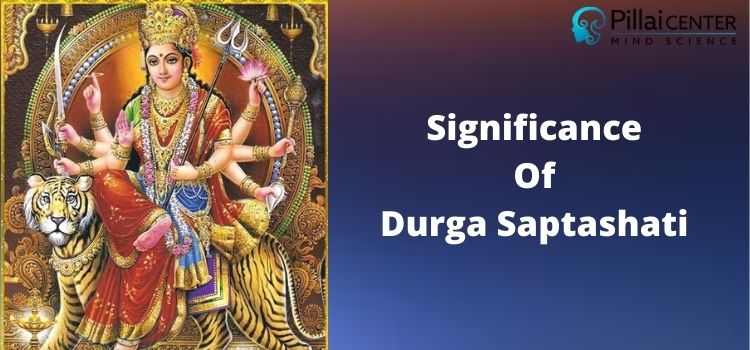Durga Saptashati – Introduction
Durga Saptashati is a powerful and popular Hindu religious text praising Goddess Durga. Goddess Durga is one of the principal deities worshipped by Hindus all over the world. Devotees look up to her as their divine mother. The Goddess features a golden complexion and sits on a lion. She has several arms that carry many types of weapons in them.
The Durga Saptashati is a part of the Markandeya Purana, one of the eighteen major Puranas, and is believed to have been composed between 400-600 CE. It extols the greatness of Goddess Durga and describes her as the supreme power and the one who created the universe.

Goddess Durga and Durga Saptashati
According to the Hindu legends, Goddess Durga, the Divine Mother, has waged many ravaging wars against sinister demons and slew them to save the universe.
Whenever the devas sought her intervention, the Goddess Durga descended and fought for the welfare of the universe. Thus, goddess Durga’s every battle with the demons is an adventure, and her exploits against the demons continue to delight the devotees and draw them towards her.
The battle tales of Goddess Durga were christened as the Durga Saptshati in the North and the Devi Mahatmiya in South India, and Chandi Path in West Bengal. Durga Saptashati consists of thirteen chapters that contain approximately 700 verses.
It is very auspicious to chant the Durga Saptashati verses during Chaitra Navratri and Sarada Navaratri. You can chant Durga Saptashati daily or on Fridays and Tuesdays, the favorite days of the Goddess.
Significance of Durga Saptashati
Durga Saptashati is a popular Sakta literature that is chanted by millions. In several regions of India, the reading of Durga Saptashati is an integral part of the nine-day Navratri ceremonies.
Durga Saptashati is also known as Devi Mahatmya and Chandi Path.
It is mandatory to chant verses from Durga Saptashati when the powerful Chandi Homa is performed. Chandi Homa is one of the most significant Homa done to bring good health and victory over enemies.
Durga Saptashati bestows one with a fearless attitude and offers protection from all kinds of negative influences. Anyone struggling in life with problems can chant Durga Saptashati to get rid of their life challenges.
The Benefits of reciting Durga Saptashati
Reciting Durga Saptashati bestows various benefits. Some of its significant benefits are below.
- Reciting Durga Saptashati can mitigate the effect of the wrong placement of planets in the birth chart.
- Those who chant this powerful stotram will receive the grace of Mother Durga, and they will be protected against their enemies and opponents.
- One who chants the Durga Saptashati will experience happiness and contentment.
- Chandi Path is very dear to Mother Durga, and one who chants it will have her grace and blessings.
- One can attain good health and stable wealth by Reciting this stotram.
- A person Reciting Durga Saptashati shall be free from debts and money issues.
- The grace of the divine mother will ensure that the genuine wishes of the devotee are realized.
- Reciting this powerful stotram will safeguard you from black magic.
- Reciting the Durga Saptashati will make a person bold enough to face the travails of life.
- A person Reciting this stotram will find a suitable life partner and good progeny.
- It is believed that reciting Durga Saptashati every day for seven days a week has different merits.
The procedure of Reciting the Durga Saptashati
For long, specific procedures are being followed while reading the Durga Saptashati during Navaratri. As mentioned earlier, there are thirteen chapters in Durga Saptashati, and there is a procedure to read these chapters during the nine days of Navaratri.
1st day: Chant the verses of Madhu kaitabha samhaaram of the 1st Chapter.
2nd day: recite the Mahishhasura samhaara covered in Chapters 2nd, 3rd, and 4th.
3rd day: Chapters 5th and 6th dealing with Dhuumralochana vadha are to be chanted.
4th day: Chanda Munda vadha, the 7th Chapter is recited.
5th day: Is ideal for Reciting the 8th chapter 8, Rakta biija samhaara.
6th day: chant the verses of the chapters 9th and 10th dealing with the Shumbha Nishumbha vadha.
7th day: recite the verses from chapter 11 that contain the praises of Goddess Narayani.
8th day: the Phalastuti contained in chapter 12 is chanted. These verses explain the merits and benefits of Reciting Durga Saptashati.
9th day: you will have to read chapter 13th containing the blessings to Suratha and the Merchant.
10th day: On the last day of the Navaratri chant, the Aparadha Kshama Prarthana Stotram in Chapter 14.
Alternatively, one can also finish the Durga Saptashati recital on the 9th day by Reciting Devi Aparadha Kshama Prarthana Stotram in advance on the 9th day. Please remember to recite the Siddha Kunjika Stotram after finishing the Reciting of every Chapter.
« Love Mantra ‘Kleem’ Creates Miracles Rahu and Ketu – Legends, Significance, Transit and Mantras »